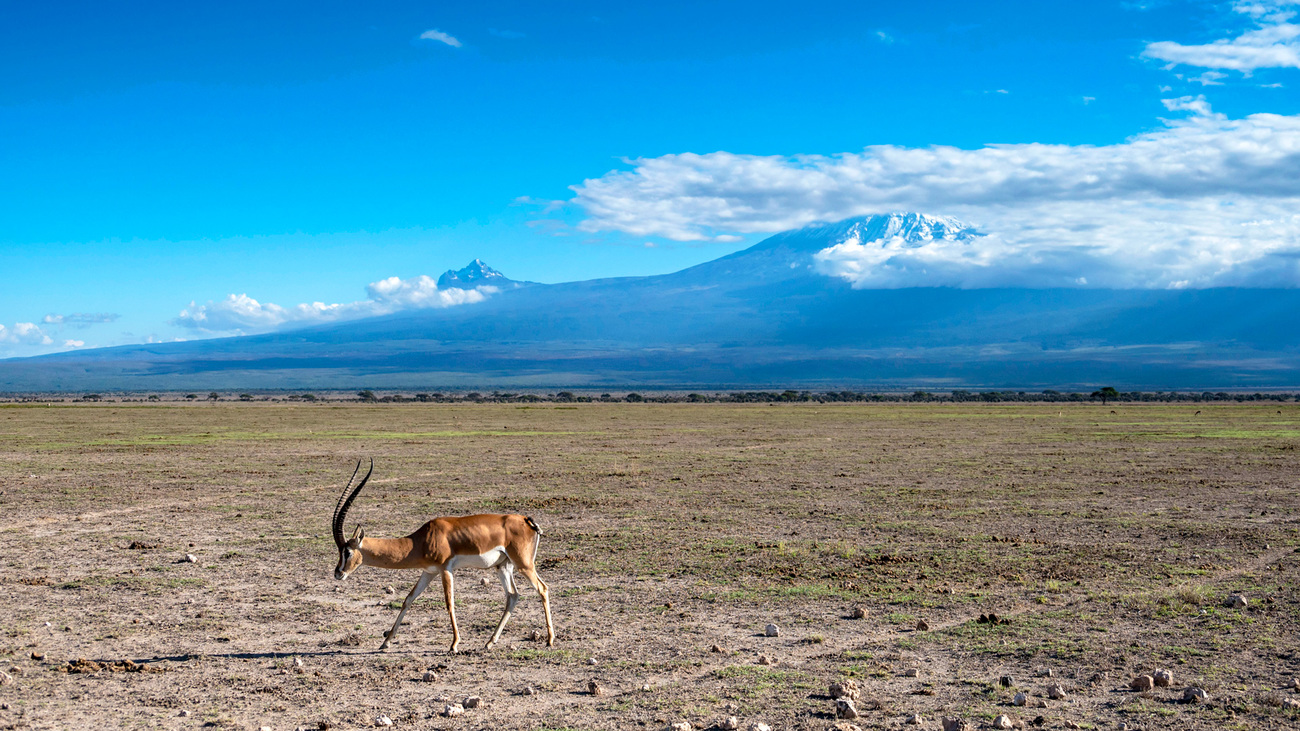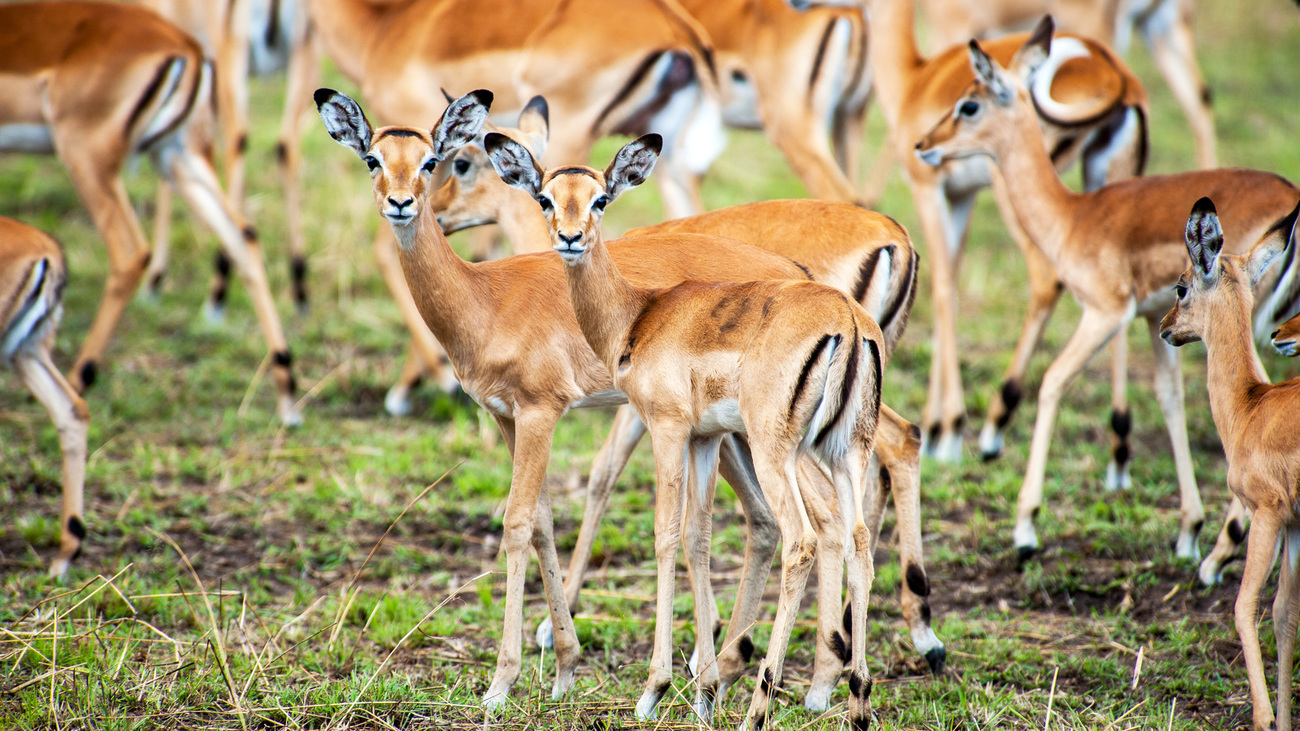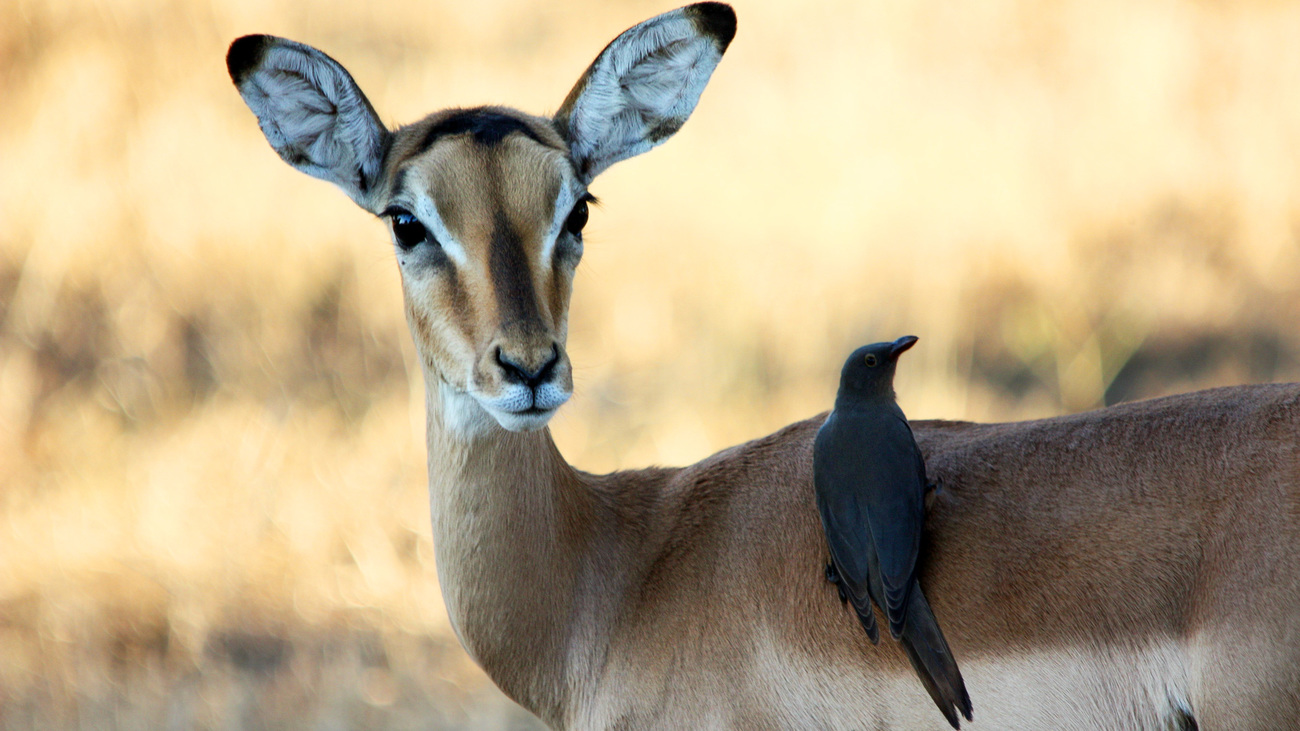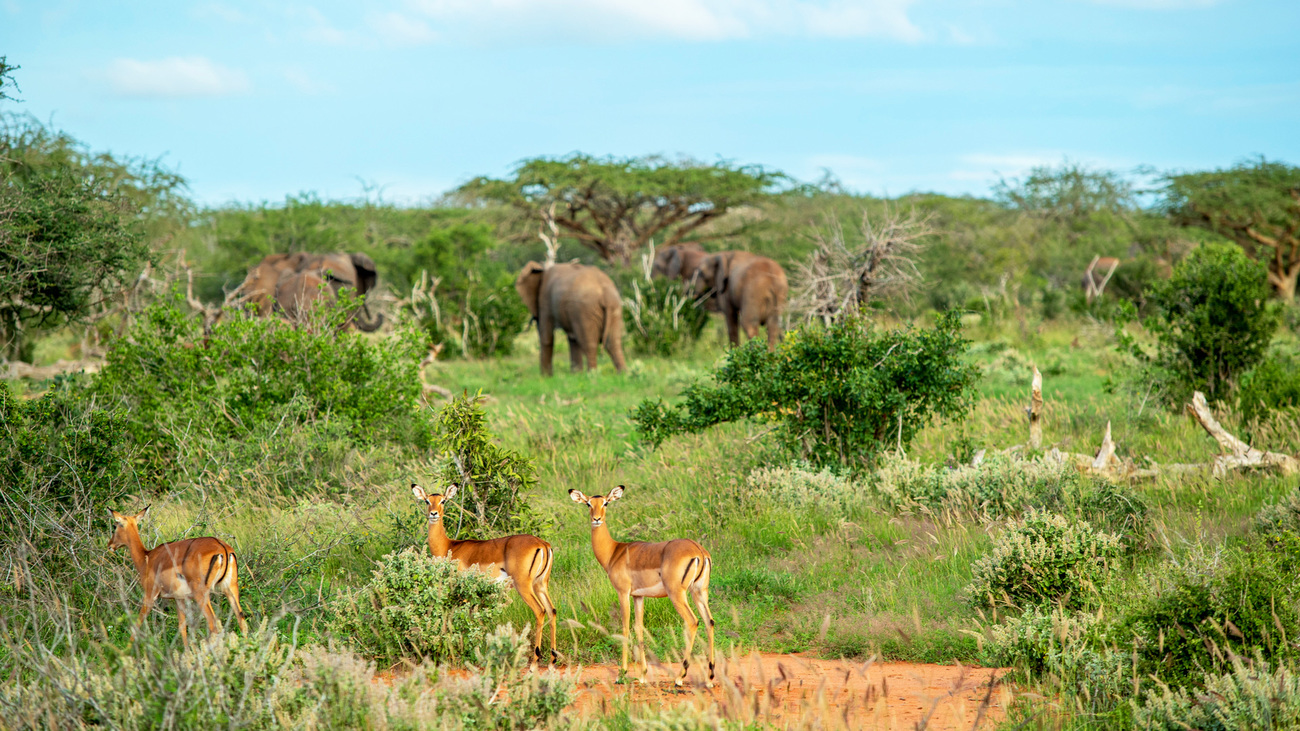Impalas
What is an impala?
An impala, also known as the rooibok, is a medium-sized species of antelope with a reddish-brown coat and white and black markings. Both males and females look very similar, though males are identifiable by their large, twisting horns. There are two subspecies of impala—the common impala and the black-faced impala—the latter of which can be distinguished by the black stripe on its face.
These antelopes live in southern and East Africa, in South Africa, Uganda, Kenya, and Tanzania. They eat leaves, shrubs, and grass in their savannah and woodland habitats. Typically, females live in large herds led by a dominant male, and a mother gives birth to a single calf after a seven-month gestation period. During mating season, other males will challenge the dominant male to gain breeding rights over the herd, though if they’re unsuccessful, they’ll join a bachelor herd with other male impalas.
Impalas are also impressive athletes. They can jump up to three times their height and run at speeds of over 90 kilometers per hour (55 miles per hour), using their bounce and speed to escape predators. Impalas play an important role in their ecosystems. They are a primary source of food for carnivores, including lions, cheetahs, and hyenas. As herbivores, impalas also help control vegetation and disperse seeds.
What is an impala’s scientific name?
The impala’s scientific name is Aepyceros melampus. It is part of the family Bovidae, which also contains cows, bison, buffalo, antelopes, sheep, and goats. However, the impala doesn’t have any close relatives and is the only member of the genus Aepyceros.
There are two subspecies of impala, including the common impala, known scientifically as Aepyceros melampus melampus, and the black-faced impala, known scientifically as Aepyceros melampus petersi.
Are impalas endangered?
Impalas are classed by the International Union for Conservation of Nature (IUCN) as least concern, with a stable population of around two million. The majority of impalas live on private land or in protected areas, but they still face various threats. Humans are encroaching on their habitats, making it harder for impalas to breed and find food. Hunting is also a problem, as impalas are one of the most frequently hunted antelopes on South African hunting safaris.
Where do impalas live?
Impalas live in Africa and are native to more than 10 African countries. Their habitat ranges from southern Africa to the northern parts of East Africa, in countries including Kenya and Uganda.
As adaptable feeders who eat grass during the rainy season and shrubs when it’s dry, impalas can live in areas that are far from water and where the grass has been stripped by livestock. They typically roam hot and dry grassland or savannah, though they can also be found in lightly wooded areas and on the borders between woodlands and savannahs.
Threats
Most impalas live on private or protected land, but that doesn’t mean their survival isn’t threatened. The main threats to impalas are hunting, habitat loss, and habitat fragmentation.

Hunting
Impalas are targeted by poachers for their horns, meat, and hides, with poachings typically taking place at the edge of—or even within—protected areas. Organized hunting safaris are also increasingly common and severely affect impala numbers across private land.
As hunting activity increases, impalas are changing their behavior in an attempt to avoid being targeted. They have started to frequent different habitats and avoid waterholes, which not only puts these impalas at risk of starvation and dehydration, but also affects the wider ecosystem that depends on them.
Habitat loss and fragmentation
Impalas are losing their habitats to agriculture and urbanization as new farmland, roads, and settlements are increasingly expanding into impala territory. This type of activity also breaks up impala habitat, making it harder for them to move between protected areas in search of food, a mate, and a safe place to give birth.
FAQs
What animal is an impala?
An impala is a medium-sized, fast-running antelope. It is the most common ruminant (a mammal that chews cud) in southern and East Africa.
What does an impala look like?
Impalas are medium-sized antelopes. They are elegant animals with slender legs, relatively long necks, and sleek, tan-coloured coats. They have white markings around their eyes, inside their ears, and on their throats, as well as black markings across the crown of their heads and on the tips of their ears. There’s also a black stripe down their hind haunches and a black tuft near their hind feet. Black-faced impalas have an extra black stripe down the front of their faces. All impalas have bushy tails with tan, black, and white stripes.
Male and female impalas look similar in terms of their coloring—but there’s one big difference. Males have large, twisting horns—the largest antelope horns in East Africa.

How big is an impala?
The impala is a medium-sized animal. Impalas tend to be 70 to 92 centimeters (28 to 36 inches) tall and weigh 40 to 76 kilograms (88 to 167 pounds). Males, with their large horns, are about 20% heavier than females.
Do impalas have horns?
Male impalas do have horns, but females don’t. Male impalas have long, twisting horns that measure 45 to 91 centimeters (18 to 36 inches) long. They use their horns to challenge each other and prove their strength during the mating season. It can take years for a young impala’s horns to reach their full length, which is why younger animals struggle to take control of a herd from an older male.
Are impalas and gazelles the same thing?
While impalas and gazelles are both species of antelope, they are not the same animal. Impalas belong to the genus Aepyceros and gazelles belong to the genus Gazella. There are 17 distinct species of gazelle but just one species of impala.
Both animals live in Africa, although gazelles can also be found in some parts of Asia. Unlike impalas, both male and female gazelles have horns. Different gazelle species vary in size and impalas are bigger—or just as big—as all of them. Most gazelles are 60 to 100 centimeters (2 to 3.5 feet) tall at the shoulder and weigh 11 to 45 kilograms (26 to 100 pounds), while impalas are 70 to 92 centimeters (28 to 36 inches) tall and weigh 40 to 76 kilograms (88 to 167 pounds).
Are impalas good jumpers?
Impalas can leap huge distances of up to 10 meters (33 feet) and jump three meters (10 feet) high. That’s around three times their height. They can easily clear bushes and other obstacles, and tend to jump over the things in their path rather than run around them. Impalas are also fast runners. They can reach top speeds of over 90 kilometers per hour (around 55 miles per hour).
This athletic skill comes in particularly useful when impalas have to escape predators. They confuse their attackers by running and jumping in all directions. In addition, impalas seem to jump about for the fun of it. Scientists have observed impalas doing high jumps together even with no predators in sight.
Do impalas live in herds?
Yes, impalas live in large herds that include up to 100 individuals. Sometimes they form even larger, multi-species herds with other herbivores, including zebra, kudu, and wildebeest—there’s safety in numbers, and herds offer protection from predators.
Older males herd groups of females, whom they guard carefully. During the mating season, dominant males work overtime, regularly fighting off other males who challenge their authority. Male impalas without their own herd of females usually belong to a bachelor herd.

How many babies do impalas have?
A female impala usually gives birth to a single impala each year around seven months after mating, and most impala births coincide with the rainy season. The mother nurses her calf for four months, before mating season rolls around again.
For the first few days of their lives, impala calves take cover in woodland or bushes to stay safe from predators. After this time, they join a nursery with other young impalas, guarded by a handful of females. The mothers and calves only reunite when it’s time to feed.
What do impalas eat?
Impalas are mixed feeders. They eat grass during the rainy season and switch to shrubs during the dry season.
Impalas are also a source of food for a range of carnivores. Eagles will swoop down to catch fawns, while lions, leopards, cheetahs, wild dogs, and hyenas prey on impalas.
Our work
IFAW works to support animals around the world, including impalas.
We have worked with partners in Zambia and Malawi, home to impalas, elephants, leopards, hyenas, and zebras, to combat wildlife crime. Poaching has been a major issue for impalas, which are targeted for their horns, meat, and hides. We partnered with law enforcement officers in both countries—training, mentoring, and equipping officers with the tools they need to combat wildlife crime effectively. As some people turn to poaching as a means of income, we worked with local communities to create job opportunities in animal protection.
We’ve also created safer habitats for hundreds of animals to boost populations. We moved 128 impalas to Kasungu National Park from Liwonde National Park as well as many elephants, buffalo, warthogs, and waterbucks.

How can you help?
Impalas are majestic animals and a vital part of their ecosystems. Support conservation to protect impalas and other animals around the world.
